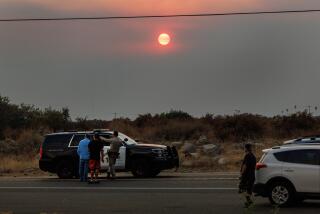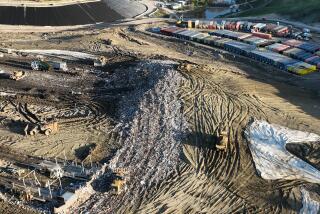Dust Levels Could Choke Coachella Valley Growth
Builders and government leaders in the Coachella Valley, the area surrounding Palm Springs, said Monday they are scurrying to contain a dust problem before federal officials take matters into their own hands--a step that could devastate plans for development.
Over the last three years, the arid region has violated federal standards for airborne dust pollution--a chronic problem that the U.S. Environmental Protection Agency attributes in large part to the rapid pace of construction in the area.
After three years, if a region exceeds the federal standard for dust--50 micrograms per cubic meter of air, according to the Clean Air Act--the EPA can impose strict limits on operations that stir up dust.
First, the agency can force the region to reduce dust in the air by 5%, said Eleanor Kaplan, an EPA environmental protection specialist based in San Francisco. Ultimately, the EPA can limit development and other construction operations that tend to choke the air with dust.
That prospect, though the Coachella Valley is not yet in danger of facing such sanctions, Kaplan said, causes shudders in a region that favors development as an engine of economic growth.
“We are very concerned about this because there could be some very drastic repercussions,” said Ed Kibbey, executive director of the desert chapter of the Building Industry Assn. of Southern California. “The EPA has the power to do just about any damn thing they want to do.”
In the past, the EPA “was just really tough” to other areas, Kibbey said.
“We don’t want that to happen here. This is a growing, vibrant area and we want to keep it that way. To close it all down would be disastrous.”
By June 30, a coalition of builders and government leaders will come up with a new dust “attainment” plan in an attempt to stave off the EPA, several officials said Monday.
The program, local officials hope, would give the Coachella Valley until 2006 to reduce its dust pollution.
“We’re taking a very proactive approach by involving the EPA at this time rather than waiting for them to drop the guillotine,” said Aurora Kerr, director of human and community resources for the Coachella Valley Assn. of Governments, a coalition of nine cities, including the Palm Springs region.
The region’s attempt to self-police its dust could result in a number of changes, officials said. For example, government agencies and builders might be required to add gravel to some dirt roads or treat the roads with chemicals that help contain dust.
One primary solution, however, could only raise new problems, officials said.
Builders might be required to spread more water on construction sites--but water is a precious resource throughout Southern California.
Still, drastic measures are needed, Kaplan said.
“They have to do something, and fast,” she said.
One group of local business and government leaders is working to figure out how much the new steps will cost, Kerr said.
Some of the costs might be shouldered by cities and Riverside County, officials said, such as the cost of paving dusty roads. But the bulk of the program will likely be paid for by builders.
“The plan will cost money. There is no question about that,” Kibbey said. “But we feel it is much better to spend a little extra money and be able to continue to build. We will bring this area back into compliance. That is a fact simply because it has to be a fact.”
More to Read
Sign up for Essential California
The most important California stories and recommendations in your inbox every morning.
You may occasionally receive promotional content from the Los Angeles Times.











